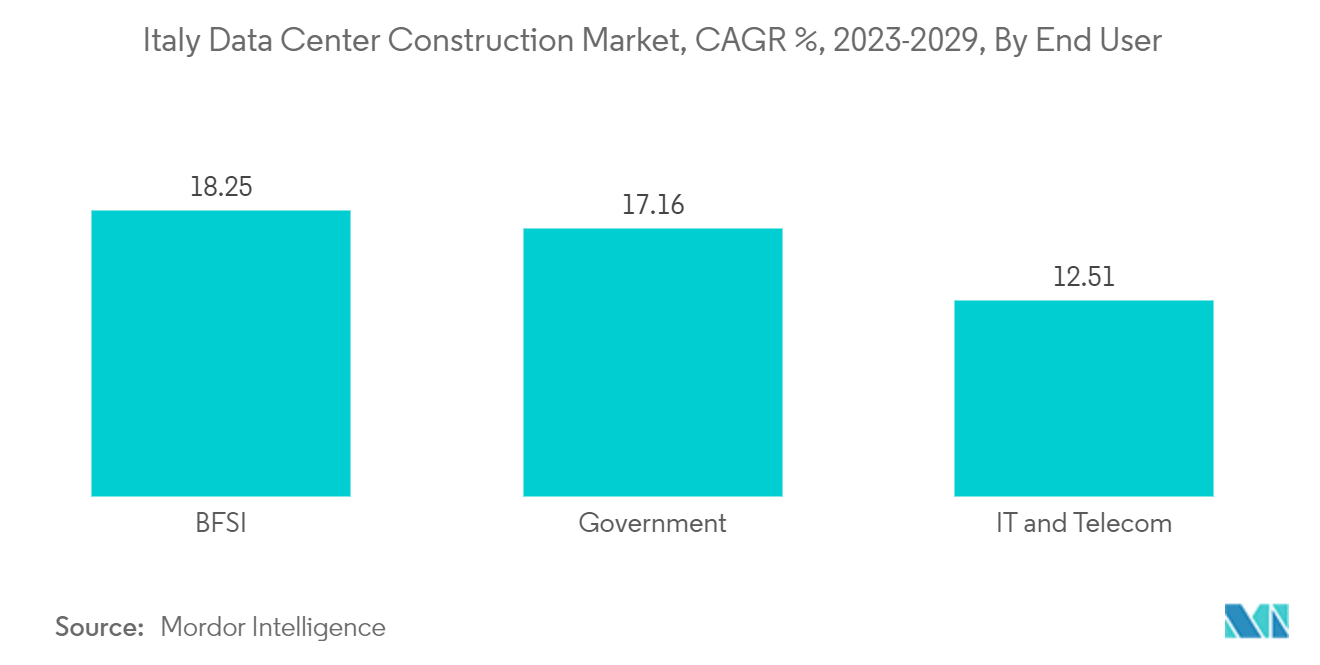Market Trends of Italy Data Center Construction Industry
BFSI to hold significant market share
- Media & entertainment, manufacturing, BFSI, e-commerce, and government services are the end users likely to catalyze growing IT load capacity by increasing data consumption. It is expected that the Italian government will improve its services, leading to a rise in power capacity from 23.8 MW in 2023 to 61.6 MW in 2029.
- The government, an end user, is projected to hold 8% of the market share in 2023 and grow to 9% by 2029. Manufacturing is expected to grow by 19.2% during the forecast period. It is expected to reach 95.8 MW in 2029. Manufacturing accounts for 23.6% of GDP. Italy has around 5,000 companies and is known for its machinery. Italy has already introduced Industry 4.0 to its manufacturing companies to cater to surplus demand.
- Automation and technology are expected to catalyze data consumption. Additionally, factors such as online shopping would contribute to the increasing generation of data and processing facilities. As users grow more inclined to online shopping with attractive deals offered, this would lead to a rise in digital payment services and traffic on websites, thus increasing data consumption. All these factors would contribute to a significant increase in consumption, boosting the demand for data centers.

Greater Milan to host more Data Center Construction during the Forecast
- Greater Milan operated at an IT load capacity of 269 MW in 2022, which is anticipated to grow from 305.5 MW in 2023 to 629 MW by 2029 at a CAGR of 12.8%. The development of smart cities in Milan and Bergamo regions may trigger the increase in smart devices, requiring data centers to process these huge pools of data, simultaneously increasing the IT load capacity over the years.
- Growing IT businesses, streaming services, and online gaming are expected to further trigger the demand. For instance, developing ICT solutions for the traffic management system to be used in these regions would enable transport planners and decision-makers to understand and predict the travel behavior of city users. The city used a network of Wi-Fi sensors to collect traffic data from the beginning of January 2020 to the end of July 2020.
- The availability of suitable land, favorable laws, and environmental factors are some considerations that help data center companies foresee the future of their establishment. Considering the growing demand and development of smart cities in the region, data center companies prefer constructing data centers in the Greater Milan region.
- The market share of massive-sized data centers is expected to increase from 8.2% in 2022 to about 34% by 2029, registering a CAGR of 36.2%. Companies like Stack Infrastructure and Compass and Hines announced plans to develop massive facilities, adding IT load capacities of 35 MW and 48 MW, respectively, in the region.
- Since most clients prefer massive facilities, small data centers may witness minimum growth during the forecast period, catering to the growth of SMEs and new customers.


